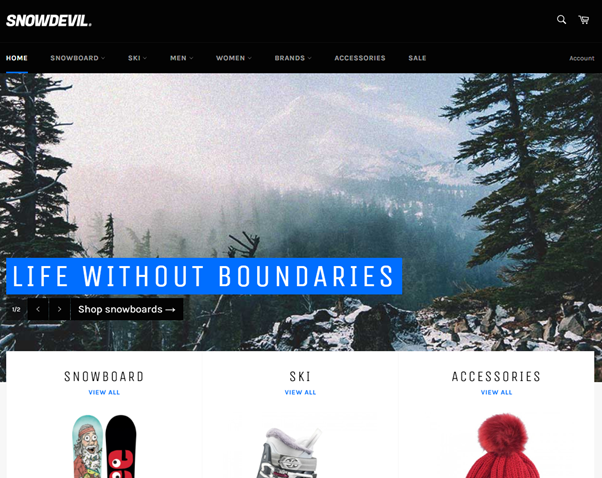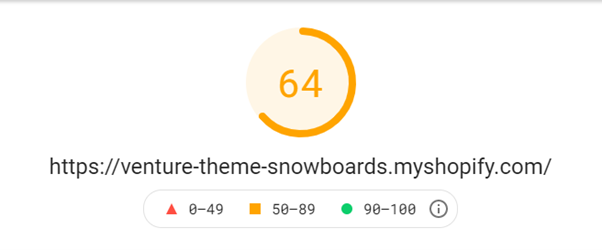Shopify SEO: Technical SEO Audit of a Free Shopify Theme
I previously wrote an article focused on the SEO effectiveness of a default Magento 2 installation where I uncovered a number of core SEO considerations that would need fixing before publishing a live site.
For the purpose of this article, I decided to analyse a free Shopify theme called Venture, designed for medium to large product inventories.

For those who do not know, Shopify is a hosted eCommerce platform available for a small monthly subscription. The platform is used by small and large businesses alike to take products to market in one of the fastest ways possible due to almost everything being configured out of the box. It also supports many extensions that enable elements such as subscriptions and product configuration to be added to your store.
Page speed
Page download speed is an organic ranking factor and brands should be aiming for their pages to download as fast as possible. Having a fast website is key to providing a positive user experience (UX) which can, in turn, help improve conversion rates.

Upon analysis, I found that the whole of this website has render blocking issues. This is where items you first see in your browser are not being loaded first. Instead, other content below the fold is loaded meaning the perceived download speed is lower than it actually could be.
All JavaScript and CSS used within the website should be minified – only the JavaScript and CSS needed to display the current page should be loaded. This removes any unused spaces and ensures files are as small as possible.
Images displayed below the fold should have their loading delayed. These images can then load in when they are scrolled into view which improves the perceived page load speed of content above the fold.
Missing XML sitemap
XML sitemaps give search engines a simple index of your website’s content. This allows search engines to quickly identify pages that have been added, edited, or removed which reduces the risk of users finding dead or out of date product information in the organic search results.
For this website, there is no reference to an XML sitemap in the robots.txt file. This is due to Shopify having a robots.txt you cannot edit.
To resolve the issue, a plugin should be used to create a live XML file of the website’s content. The XML sitemap file should then be linked from within the pages <head> before adding the XML file into search engines such as Google and Bing alongside Search Console and Webmaster tools.
Thin content
Search engines are text readers and to preserve their market share, they must serve the most relevant content to users. To support your website in being served for relevant searches and to improve your organic performance, you should feature comprehensive content onsite.
Pages on this example site contain only a few sentences at most. This is likely due to the site being a demonstration of the theme and not a functional eCommerce website. However, I recommend that all categories fully explore their topical theme. This information can then be supported by further explanations and detail across blogs and FAQ sections.
Login and cart pages blocked by robots.txt
The robots.txt file controls which content search engines can index which can have an overall effect on the organic performance of the website.
The login and cart pages are linked site wide and will gain a high page authority score. Blocking search engine access to these pages means that this authority cannot be passed onto commercial content.
I would recommend removing the block in robots.txt and instead, the pages should make use of the meta robots tag. This would block indexing but allow page authority to pass through them. However, this would need to be something Shopify does themselves as, by default, shop owners do not have the ability to edit robots.txt.
To work around this, the link to the basket/checkout systems could be removed when there are no products in the cart to be viewed. A link would only become active once an item was added. This would redistribute the page authority from this page to your more commercial content. This would look like:
<meta name=”robots” content=”noindex, nofollow”>
Internal redirects
Content is usually redirected when removed or as part of a platform migration. Each redirect potentially reduces the page authority passed through the link and could impact organic performance.
On the example website, approximately 40 percent of internal links are redirected. This appears to be due to the URLs changing to remove the ‘/collections/’ folder.
I would recommend that all redirected links are replaced by direct links. The redirects from old to new URLs should remain as this helps any lingering search results to continue contributing to site traffic.
Duplicate title tags
Title tags are the clickable links found in organic search results and are an SEOs main method of guiding organic rankings.
Having duplicate title tags means the site is not optimised to achieve a wide market reach. In the same way, under optimised or short title tags will also limit your page’s market reach.
We recommend that each page has a long title tag containing descriptive long tail keywords with the most relevant keywords positioned within the first 60 pixels of the tag. This will help your site’s visibility and highlight potential ranking quick wins.
Missing, duplicate and under optimised meta descriptions
Meta descriptions do not affect a page’s organic ranking. They are also often ignored by Google and replaced with snippets of text taken directly from the page, however, they can help improve organic click through rates.
I advise that once higher priority actions are complete, meta descriptions should then be optimised. Each one should be unique to the page, contain the target keywords and be approximately 156 characters long.
Missing and duplicate H1s
The H1 is the headline for a page and is useful for communicating the content theme. We recommend that each page has a unique H1 that reflects the main target keyword for the page. It’s also important that your H1s aren’t duplicated as this will limit your page’s relevancy which can then affect organic rankings.
Structured data validation warnings
The example site makes use of structured data, which is also referred to as Microformats or Schema. Using these tags give search engines a greater context around the purpose of your content.
For example, on an eCommerce page the price or stock availability could be tagged. Search engines can then use this data within the organic results to give your listing more real-estate which can, in turn, improve organic click through rates.
Unsafe cross origin links
Links created using the target=”” attribute is a potential security risk which could allow the target site to feedback malicious scripts. In this case, I would suggest adding the attributes rel=”noopener noreferrer” to these links to mitigate the issue.
Protocol relative resource links
Internal links use // instead of the full https:// prefix which could cause security issues. We recommend all // links be replaced with their full https:// version.
Missing X Frame Options Header
Frames and iFrame use on the website could cause security issues. We advise using the X-Frame-Options response header with a ‘DENY’ or ‘SAMEORIGIN’ value to avoid this being a problem.
Missing secure referrer policy header
Traffic through the website using HTTPS is potentially leaking non-secure information.
We suggest adding ‘no-referrer-when-downgrade’, ‘strict-origin-when-cross-origin’, ‘no-referrer’ or ‘strict-origin’ policies in the Referrer-Policy header to mitigate this issue.
Involving your SEO agency in the early stages
As you can tell from the analysis, there are a number of factors to consider in order to get this default Shopify theme SEO ready. All things considered, Shopify is an effective eCommerce platform with minimal out of the box issues. Many of the issues noted in this article are due to the website not being a real eCommerce store. However, some of the issues are limited by what can be done within Shopify and the remaining technical issues could be easily resolved using an experienced Shopify developer.
Many eCommerce web development agencies consider SEO when building a new website. However, as this isn’t their specialism, these considerations are often limited to providing out of the box access to factors such as editing title tags, meta descriptions and ensuring there’s an XML sitemap.
Involving your SEO agency in the earlier stages of your web project helps to mitigate issues before they become a performance problem and will consider:
- Competitor SEO analysis and best practice
- International targeting
- SEO platform and/or domain migration
- Optimised site architecture and product categorisation
- Comprehensive, optimised content
- Pre-launch and post-launch technical SEO audits
When building your eCommerce store, we would always recommend always asking for help from a dedicated Shopify specialist agency and hiring an SEO agency to consider the organic elements of your site. Contact us if you need more advice on considering your SEO within your web project.